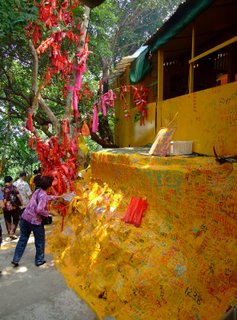
Kusu Island, Singapore
Fujifilm 9500
f5 1/50s iso80
why tortoise all look so zuai3....

Chinese Temple...

and Malay Temple.
History of Kusu Island (Taken from a signboard on the island)
 In March 1616 Dom Jose De Silva, Spanish Governor of the Philippines was homeward bound with his fleet of 10 galleons and 2 galleys when his galleon grounded on a reef in the civinity. Tradition has it tha the accident took place at hte Kusu Reef itself and hence the island became first known in the 17th Century as "Governnor's Island" and the Singapore Straits as the "Governor's Straits".
In March 1616 Dom Jose De Silva, Spanish Governor of the Philippines was homeward bound with his fleet of 10 galleons and 2 galleys when his galleon grounded on a reef in the civinity. Tradition has it tha the accident took place at hte Kusu Reef itself and hence the island became first known in the 17th Century as "Governnor's Island" and the Singapore Straits as the "Governor's Straits".in 1806, James Horsburg, Hydrographer to the British East India company renamed it "Goa Island" for reasons not known. Then, in 1819 the island gained prominences again when Daniel Ross, Hydrographer to Sir Stamford Raffles surveyed the harbour and established the island as a reference point for all ships entering the port.
Subsequently in 1822 a signal station ith a signal mast was erected on the island and it was manned by the staff of the Harbour Master's Department.
Kusu which means "Tortoise Island" in Chinese, is also known as Peak Island or Pulau Tembakul in Malay. It is situated about 5.6km from Singapore. The island was transformed from two tiny outcrops on a reef into a holiday resort (edit:duh!) seven times larger in size from 1.2 hectares to 8.5 hectares in 1975.
Kusu Island has a religious and legendary background. There is a Malay shrine and a Chinese temple on the island. During the Kusu Festival in the Ninth Lunar Month every year, thousands of devotees make their pilgrimage to the island to pray for good health, peace, happiness, good luck and prosperity.
Prior to the reclamation and implementation of ferry services, in 1975, devotees had to make their way to Kusu in sampans or bumboats.

not very interesting right? let's see another story
 There was once a Chinese fisherman who lived on the island of Singapura. His family was poor so he had to go out to sea everyday to catch fish to sell. One day, although there was a thunderstorm, he insisted on going out to sea, against his wife's advice.
There was once a Chinese fisherman who lived on the island of Singapura. His family was poor so he had to go out to sea everyday to catch fish to sell. One day, although there was a thunderstorm, he insisted on going out to sea, against his wife's advice.The choppy waters and heavy rain made it very difficult to fish. The fisherman's little boat swayed vigorously from side to side. As he was about to throw his net into the sea, a huge wave rocked his boat, causing him to lose his balance and fall into the sea. "God, please help me!" he screamed in the water, "Who is going to take care of my wife and children?"
Just when the fisherman was about to give up, a large turtle swam slowly towards him. It was the biggest turtle he had ever seen! To his surprise, the turtle signalled to him to climb onto its back and carried him safely to a nearby island.
The Chinese fisherman soon made the island his home. He was able to live quite well, as fruits grew abundantly on the island.
One stormy day, while the fisherman was resting, he heard a loud cry. "Help! Help! I am drowning!" a man cried. Guess what the fisherman saw? The same turtle that helped him was carrying a Malay fisherman to the island!
The two men soon became good friends. They spent their time hunting for animals and fruits.
To thank the turtle for saving their lives, the two men built a Chinese temple, a Malay shrine and a huge turtle sculpture, all of which can still be found on Kusu Island, which is also known as Turtle Island.
Today, during the ninth month of the lunar calendar (usually October in the calendar we use now), many Chinese go to Kusu Island to pray to Tua Pek Kong, the deity of prosperity, at the Chinese temple.

this is more interesting right? uniquely singapore? try harder.



No comments:
Post a Comment